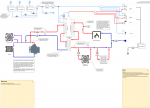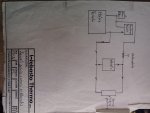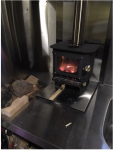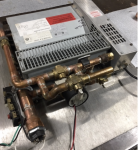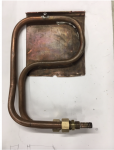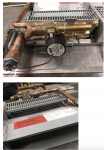Jocke
New member
Hi all,
This is my first post here, so I think it's appropriate to first say thanks to everybody who's posting and replying to posts. There's so much information to digest and this site is truly valuable. Thank you all!
I've been lurking, reading, researching, searching, etc and I've done an attempt in designing our water and heating system. This is based on so many resources on the net and books that it all makes my head spin.
I'd love to hear your thoughts on our diagram - attached as PDF and PNG. I think I've got many "in theory" parts figured out but there's still some practical points that I haven't figured out fully. Also we're very keen on hearing your thoughts of what components to use, or even more important, which ones not to use. So all info and tips are greatly appreciated!
The idea is to build an Overland Camper based on an ex-Bundeswehr Unimog U1300L. As it's an old vehicle and we might end up in colder climates, we want to be able to heat the engine (maybe truck cab and even truck batteries). We're also planning a shower so we need hot water for that. For heat distribution we're thinking of underfloor heating, a fan assisted water-to-air heat exchanger, (maybe a towel rail too). Powered by a diesel heater such as an Eberspacher Hydronic unit - to be decided.
The things that I haven't really figured out yet.
1) Where to plumb into the engine? I thought that the hot return pipe between the engine and the radiator would be a good idea. But then, when heating the engine from the camper heater we'd be losing heat through the radiator. Or where's the best spot to plumb in?
2) I'm assuming the engine water loop needs a pump so that we can force the water round the block?!
3) Will heating the block, with the aforementioned pump, also heat the truck cabin if I switch on the truck cab heater and power up the truck cab fan?
4) I've specced a two-coil calorifier (with electric heater element), one for the engine heating loop and one for the camper heating loop. The idea is to keep the camper heating circuit separate from the truck engine heating circuit. I've also added a plate heat exchanger between these two loops. Is this required or have I over-engineered it all? If so, which components are superfluous?
5) I'm also assuming that the truck engine loop should be turn-off:able with some valves so that a) the engine can heat up properly before putting heat into the calorifier and/or camper, but also in the other direction; b) to not waste heat on the block when stationary for longer periods? I've specced two valves there. Is that how it's done?
6) I'm also assuming the camper heating loop needs a safety valve and an expansion tank?!
7) Naturally all parts need to be able to be drained and bled of air.
8) What philosophy should I adapt with regards to pumps? Where do I position them? Are they needed?
Like I said, my head's spinning from all this (and the electrical diagram too!) I'm sure I've got tons more questions, but one step at a time.
I'm sure I've got tons more questions, but one step at a time.
And thanks again for all your insights and any tips and thoughts you might have.
This is my first post here, so I think it's appropriate to first say thanks to everybody who's posting and replying to posts. There's so much information to digest and this site is truly valuable. Thank you all!
I've been lurking, reading, researching, searching, etc and I've done an attempt in designing our water and heating system. This is based on so many resources on the net and books that it all makes my head spin.
I'd love to hear your thoughts on our diagram - attached as PDF and PNG. I think I've got many "in theory" parts figured out but there's still some practical points that I haven't figured out fully. Also we're very keen on hearing your thoughts of what components to use, or even more important, which ones not to use. So all info and tips are greatly appreciated!
The idea is to build an Overland Camper based on an ex-Bundeswehr Unimog U1300L. As it's an old vehicle and we might end up in colder climates, we want to be able to heat the engine (maybe truck cab and even truck batteries). We're also planning a shower so we need hot water for that. For heat distribution we're thinking of underfloor heating, a fan assisted water-to-air heat exchanger, (maybe a towel rail too). Powered by a diesel heater such as an Eberspacher Hydronic unit - to be decided.
The things that I haven't really figured out yet.
1) Where to plumb into the engine? I thought that the hot return pipe between the engine and the radiator would be a good idea. But then, when heating the engine from the camper heater we'd be losing heat through the radiator. Or where's the best spot to plumb in?
2) I'm assuming the engine water loop needs a pump so that we can force the water round the block?!
3) Will heating the block, with the aforementioned pump, also heat the truck cabin if I switch on the truck cab heater and power up the truck cab fan?
4) I've specced a two-coil calorifier (with electric heater element), one for the engine heating loop and one for the camper heating loop. The idea is to keep the camper heating circuit separate from the truck engine heating circuit. I've also added a plate heat exchanger between these two loops. Is this required or have I over-engineered it all? If so, which components are superfluous?
5) I'm also assuming that the truck engine loop should be turn-off:able with some valves so that a) the engine can heat up properly before putting heat into the calorifier and/or camper, but also in the other direction; b) to not waste heat on the block when stationary for longer periods? I've specced two valves there. Is that how it's done?
6) I'm also assuming the camper heating loop needs a safety valve and an expansion tank?!
7) Naturally all parts need to be able to be drained and bled of air.
8) What philosophy should I adapt with regards to pumps? Where do I position them? Are they needed?
Like I said, my head's spinning from all this (and the electrical diagram too!)
And thanks again for all your insights and any tips and thoughts you might have.

